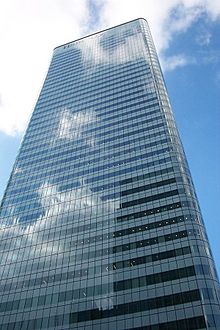Investor architecture
Investor architecture (sometimes used synonymously: commercial architecture ) is a common but fuzzy and controversial term in German-speaking countries for “primarily profit-oriented construction” for various uses ( residential , office , commercial or commercial buildings ).
Definition of terms
The origin of the term is unclear. It is consistently used pejoratively , by architects , architecture critics or citizens' initiatives to point out the negative effects of the real or supposed primacy of the economy, which is opposed to the public interests to be taken into account in every architecture - in durability, in identity through the preservation of established milieus, building structures, Urban spaces and cityscapes, affordable living space or the like. In this sense, investor architecture refers to projects that are one-dimensionally shaped by the particular economic interests of their investor who have no personal relationship with the investor in various aspects, from typology to construction technology to the choice of materials Architecture, for example as a user. On the other hand, “in common usage” this term has established itself especially “for powerfully dimensioned and monotonously structured structures made of steel and glass - often with thin, curtained natural stone sections - whose flat facades are explained by the fact that inside, the aim is to maximize profitable usable space arrives. "The term suffers" from a very interchangeable content ", was diagnosed accordingly:" Whenever something turns out too big, too monotonous, too ostentatious or too ugly, the abusive term is used. "
Investor architecture versus architecture icon
The negative connotation, although often emphasized by the adjectives "banal", "anonymous" or "faceless", is already carried by the term itself, as it implicitly contains a difference between investor architecture and regular, legitimate architecture, a separation into " Yield-oriented ' real estate ' and sophisticated ' architecture '. ”The opposite term to investor architecture is that of the architectural icon. This aesthetically evaluative charge of the term raises contradictions when buildings by well-known architects with architectural standards that are realized as investor projects are also subsumed under investor architecture . Examples mentioned in this context are the HSBC Tower in London's Docklands by Sir Norman Foster or the “Emporia” shopping center by the Swedish architect Gert Wingårdh in Malmö. And for the entire oeuvre of the Dutch architect Rem Koolhaas , "his office OMA and his urban-sociological research department AMO," it was said that it fluctuated "between built criticism and commercial architecture".
Investor architecture versus discursive / dialogical planning
Another common definition approach points to the proximity of the “genius principle of the artist architect” and investor interests, both of which, on the other hand, would be incompatible “with a discursive understanding of urban planning.” This criticism combines such different theoretical approaches as the position of “dialogical design” by My gmp delimiting this respect to the two extremes of a "conforming pragmatic" and "mono-logical-handed" position, or the model of careful urban renewal of Hardt-Walt Hämer .
See also
literature
- Werner Sewing : Berlin architecture . In: Arch + . No. 122 , June 1994, ISSN 0587-3452 , pp. 60-69 ( archplus.net [accessed October 22, 2017]).
- Rotraut Weeber, Hennes Weeber, Gert Kähler : Architecture as an investment - what counts when companies build . In: Federal Ministry for Transport, Building and Housing (Ed.): Baukultur! Information, arguments, concepts. Second report on building culture in Germany . Junius, Hamburg 2005, ISBN 3-88506-557-6 , p. 86-93 .
- Empire State of Real Estate: Architecture of Lucrative Speculation. Special issue Archithese No. 4, 2004, ISBN 978-3-03862-215-4 .
- Ursula Seibold-Bultmann: Still (not) bored? In: Neue Zürcher Zeitung . October 3, 2014 ( nzz.ch [accessed October 21, 2017]).
- Jan Friedrich: investor architecture, artist architecture . In: Bauwelt . tape 108 , no. 3 , 2017, ISSN 0005-6855 , p. 2 ( bauwelt.de [PDF; 117 kB ; accessed on October 22, 2017]).
Web links
- Ute Maasberg: Interview with Amandus Sattler. Thinking about investor architecture. In: goethe.de. Goethe-Institut eV, 2015, accessed on October 22, 2017 .
- Till Briegleb: Tear it off again immediately! Episode 24: Investor Architecture. In: Art. The art magazine. January 6, 2016, accessed October 22, 2017 .
Individual evidence
- ↑ The term commercial architecture is sometimes used differently for architecture that is used for trade. Architecture and commerce. June 27, 2008. A symposium on building culture and inner city development in Lower Saxony. accessed on October 22, 2017 (PDF; 5.9 MB).
- ↑ a b c d Ursula Seibold-Bultmann: Still (not) a boredom? In: Neue Zürcher Zeitung , October 3, 2014, accessed on October 21, 2017.
- ↑ Till Briegleb: Tear it off again immediately! Episode 24: Investor Architecture. ( Memento of the original from August 19, 2017 in the Internet Archive ) Info: The archive link was inserted automatically and has not yet been checked. Please check the original and archive link according to the instructions and then remove this notice. Art. Das Kunstmagazin , January 6, 2016, accessed on October 22, 2017.
- ↑ International Festival for Films on Art DOKU.ARTS 2015. bundesstiftung-baukultur.de, accessed on October 22, 2017.
- ^ Roman Hollenstein: Rem Koolhaas total. Neue Zürcher Zeitung , April 15, 2004, accessed on October 23, 2017.
- ^ Werner Sewing: Berlin architecture. In: Arch + , No. 122, June 1994, pp. 60-69, accessed on October 22, 2017.
- ↑ Meinhard von Gerkan: Dialogical Design (1986) In: Architektur im Dialog. Texts on architectural practice. Ernst & Sohn, Berlin 1995, pp. 81–82.

